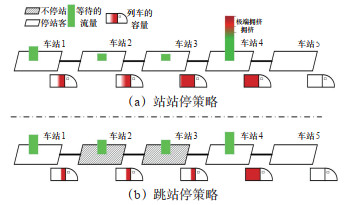A Safety-oriented Optimization Model for Train Skip-stop Strategy of Oversaturated Metro Lines
-
摘要: 为缓解高峰时段地铁过饱和线路的客流极端拥挤情况,从安全角度出发,以降低线路客流聚集风险和乘客总等待时间为目的,研究了地铁跳站停车策略优化问题。考虑随时间变化的动态客流需求,通过构建列车跳停、追踪运行、乘客动态加载等约束,推算出跳站停车策略下各车站乘客的动态聚集人数,并设计了独特的客流聚集风险评估函数。在传统只考虑乘客等待时间的列车跳停策略优化模型的基础上,将客流聚集风险纳入到模型的目标函数中,构建了以安全为导向的地铁跳站停车策略优化模型。考虑到模型的非线性特性,设计了适用于问题的可变邻域搜索算法(VNS),提出了3类邻域新解的产生方式,并设置违反约束的惩罚函数,以提高求解效率。以北京地铁八通线为例,对其早高峰和部分平峰时段(07:00—10:40)下行方向42趟开行列车的停站策略进行了优化实验。结果表明:所提出的模型可在5 min内求解出高质量的列车跳停方案,能有效缓解极端拥堵,提升客运服务质量。对比发现,相对于传统站站停策略,列车跳停策略下,车站最大等待人数由5 299人减少到2 495人,客流聚集风险降低了98.7%。在客运服务水平方面,乘客的平均等待时间由9.49 min降低到9.15 min,降低了3.6%。
-
关键词:
- 城市地铁 /
- 跳站停车策略 /
- 运营安全 /
- 可变邻域搜索(VNS) /
- 过饱和线路
Abstract: In order to alleviate the extreme congestion of oversaturated passenger flow of metro lines during peak hours, an optimization problem of skip-stop strategy for metro trains is studied from the respective of safety, which aims to minimize both risk of passenger congestion and their waiting time. Due to varying passenger demands over time, the number of waiting passengers under the train skip-stop strategy is estimated at each station by considering multiple constraints, including skip-stop operation, train tracking, and dynamic loading of passengers, and a specific evaluation function is formulated to measure the risk of passenger congestion. Based on an optimization method for the traditional train skip-stop strategy only considering passenger waiting time, a safety-oriented optimization model is proposed by integrating risk of passenger congestion into its objective function. Due to nonlinear characteristics of the proposed model, a variable neighborhood search algorithm (VNS) is designed to improve computation efficiency, where three types of novel neighborhood solutions are presented, and a penalty function is set for constraint violations. Taking Beijing Batong metro line as a case study, the proposed optimization model for train skip-stop strategy is tested for the downstream direction with 42 operating trains during morning peak hours and a part of off-peak hours (from 07:00 to 10:40 am). The experiment results show that the proposed algorithm can find high-quality train skip-stop schemes within 5 min, which can significantly relieve passenger congestion and improve service quality. Compared with the scenario where trains stop at all stations, the maximum number of waiting passengers with the train skip-stop strategy decreases from 5 299 to 2 495 over all the stations, and the risk of passenger congestion is reduced by 98.7%. At the same time, the average passenger waiting time decreases from 9.49 min to 9.15 min, reduced by 3.6%. -
表 1 符号与索引
Table 1. Symbols and Indexes
符号与索引 定义 符号与索引 定义 S 车站集合,S={1, 2, …,|S|} tp p组乘客到达站台的时间,∀p ∈ P k, s 车站索引,∀k, s∈S t停 列车停留时间 I 列车集合,I={1, 2, …,|I|} tr 相邻2列车的最小安全追踪间隔 i, j 列车索引,∀i, j∈I μ 乘客聚集风险系数 [0, T] 考虑的时间范围 tsy 到达s站时列车在区间内的总运行时间 p 乘客需求组索引,∀p∈P Nmax 车站最大连续不停站列车次数 p 乘客需求组集合,P = {1, 2, …|P|} Uk k站可容纳的等待乘客的安全数量 Hk k站可容纳的等待乘客的最大数量 op p组乘客的始发站,∀p ∈ P C 超员情况下列车最大承载容量 dP p组乘客的目的站,∀p∈P M 1个较大的正数 表 2 中间变量表
Table 2. Indirect variables
中间变量 定义 中间变量 定义 np p组乘客的数量,∀p ∈ P vki 列车i从k站出发时的载客量,∀i ∈ I, k ∈ S tdsi 列车i在s站的出发时间,∀i ∈ I, s ∈ S tdsi 列车i在s站的到达时间,∀i ∈ I, s ∈ S lk, si 在k站列车i出发时遗留的去往s站的乘客数量,∀i ∈ I, k ∈ S wki 在k站等待登上列车i的乘客数量,∀i ∈ I, k ∈ S cki 列车i在k站剩余的载客容量,∀i ∈ I, k ∈ S wki, e 在k站等待登上列车i的有效乘客数量,∀i ∈ I, k ∈ S aki 列车i在k站下车的乘客数量,∀i ∈ I, k ∈ S wk, si 在k站等待登上列车i去往s站的乘客数量,∀i ∈ I, k ∈ S wk(t) k站t时刻等待的乘客数量,k ∈ S, t ∈[0, T] nbki 在k站不会登上列车i的乘客数量,∀i ∈ I, k ∈ S wk k站的乘客总等待时间,k ∈ S bki 在k站登上列车i的乘客数量,∀i ∈ I, k ∈ S rk(t) k站t时刻乘客聚集的风险值,k ∈ S, t ∈[0, T] bk, si 在k站登上列车i去往s站的乘客数量,∀i ∈ I, k ∈ S rk k站的总风险值,k ∈ S 表 3 求解参数
Table 3. Solving parameters
参数 符号 值 列车数量/列 |I| 42 车站数量/站 |S| 13 超员情况列车最大承载容量/人 C 1 860 停站时间/min t停 1 等待乘客的安全数量/人 Uk 2 000 等待乘客的最大数量/人 Hk 4 000 相邻列车最小安全间隔/min tr 2 车站最大连续不停站列车次数 Nmax 3 目标权重 θ1,θ2 0.5 乘客积累风险系数 μ 2 表 4 各车站跳站列车的编号和总次数
Table 4. Number and total number of skip-stop trains at each station
车站名称 跳站列车的编号 跳站列车总次数/列 土桥 - 0 临河里 1, 6, 13, 14, 16, 18, 23, 25, 30, 35, 37, 41 12 梨园 1, 5, 7, 9, 10, 12, 13, 16, 17, 19, 24, 25, 28, 32, 34, 36, 38, 40 18 九棵树 6, 15, 17, 18, 21, 22, 23, 26, 27, 31, 32, 39, 40, 41 14 果园 4, 7, 11, 12, 13, 15, 17, 18, 22, 23, 24, 26, 39 13 通州北苑 2, 8, 11, 12, 16, 18, 20, 21, 22, 24, 27, 29, 31, 32, 40 15 八里桥 3, 5, 8, 10, 11, 12, 17, 18, 21, 22, 26, 27, 30, 33, 35, 40 16 管庄 1, 6, 7, 10, 12, 14, 15, 19, 20, 21, 23, 24, 27, 29, 30, 33, 34, 39 18 双桥 9, 11, 13, 14, 18, 20, 21, 28, 30, 31, 33 11 传媒大学 1, 3, 8, 9, 14, 16, 19, 20, 22, 23, 25, 28, 29, 32, 35, 38 16 高碑店 11, 14, 15, 16, 19, 20, 21, 25, 26, 29, 31, 33, 37, 39 14 四惠东 1, 4, 9, 10, 12, 15, 17, 19, 23, 24, 31, 34, 37, 41 14 四惠 - 0 表 5 站站停与跳停策略的求解结果
Table 5. Result of all-stop and skip-stop strategies solving
运营模式 目标函数 总等待时间/min 平均等待时间/min 风险值 最大等待乘客数量/人 跳站停 374 047.0 743 104 9.15 4 990 2 495 站站停 581 381.5 771 343 9.49 391 420 5 299 表 6 车站最大列车连续不停策略
Table 6. Maximum continuous train strategy at the station
策略 连续不停站的车次数 总乘客等待时间/min 上游车站乘客平均等待时间/min 风险值 策略1 2 761 648 5.81 32 876 策略2 3 743 104 6.35 4 990 表 7 权衡系数的取值
Table 7. The value of the trade-off coefficient
θ1/θ2 总乘客等待时间/min 最大等待乘客数量/人 风险值 0/1 774 395 2 084 694 0.2/0.8 771 283 2 163 1 394 0.4/0.6 760 624 2 456 1 778 0.6/0.4 735 768 2 531 8 634 0.8/0.2 723 816 2 724 30 300 1/0 710 960 2 881 52 682 -
[1] 刘晓华, 韩梅, 陈超. 城市轨道交通车站联合客流控制研究[J]. 城市轨道交通研究, 2014, 17(5): 106-108+114. https://www.cnki.com.cn/Article/CJFDTOTAL-GDJT201405028.htmLIU X H, HAN M, CHEN C. Research on joint passenger flow control of urban rail transit station[J], Urban Mass Transit, 2014, 17(5): 106-108+114. (in Chinese) https://www.cnki.com.cn/Article/CJFDTOTAL-GDJT201405028.htm [2] 曾璐, 刘军, 秦勇, 等. 基于网络可控性的城市轨道交通客流网络限流优化控制方法[J]. 铁道学报, 2018, 40(4): 1-8. doi: 10.3969/j.issn.1001-8360.2018.04.001ZENG L, LIU J, QIN Y, et al. Optimal control method for passenger flow limitation in urban rail transit network based on network controllability[J]. Journal of the China Railway Society, 2018, 40(4): 1-8. (in Chinese) doi: 10.3969/j.issn.1001-8360.2018.04.001 [3] 赵鹏, 姚旭, 余东. 高峰时段城市轨道交通线路客流协调控制[J]. 同济大学学报(自然科学版), 2014, 42(9): 1340-1346+1443. https://www.cnki.com.cn/Article/CJFDTOTAL-TJDZ201409006.htmZHAO P, YAO X, YU D. Cooperative passenger inflow control of urban mass transit in peak hours[J]. Journal of Tongji University(Natural Science), 2014, 42(9): 1340-1346+1443. (in Chinese) https://www.cnki.com.cn/Article/CJFDTOTAL-TJDZ201409006.htm [4] 郇宁, 张金萌, 姚恩建. 考虑效率与公平的城轨网络客流协同控制优化模型[J]. 东南大学学报(自然科学版), 2020, 50 (6): 1148-1155. https://www.cnki.com.cn/Article/CJFDTOTAL-DNDX202006023.htmHUAN N, ZHANG J M, YAO E J. Coordinated optimization model for passenger flow control in metro network considering both efficiency and equity[J]. Journal of Southeast University(Natural Science Edition), 2020, 50(6): 1148-1155. (in Chinese) https://www.cnki.com.cn/Article/CJFDTOTAL-DNDX202006023.htm [5] 姚晓平, 赵凯, 乔凯, 等. 城市轨道交通网络客流协同控制模型研究[J]. 中南大学学报(自然科学版), 2015, 46(1): 342-350. https://www.cnki.com.cn/Article/CJFDTOTAL-ZNGD201501046.htmYAO X P, ZHAO K, QIAO K, et al. Modeling on coordinated passenger inflow control for urban rail transit network[J]. Journal of Central South University(Science and Technology), 2015, 46(1): 342-350. (in Chinese) https://www.cnki.com.cn/Article/CJFDTOTAL-ZNGD201501046.htm [6] 石俊刚, 杨静, 杨立兴. 以安全为导向的地铁高峰时段多车站客流协同控制模型[J]. 交通运输系统工程与信息, 2019, 19(1): 125-131. https://www.cnki.com.cn/Article/CJFDTOTAL-YSXT201901020.htmSHI J G, YANG J, YANG L X. Safety-oriented cooperative passenger flow control model in peak hours for a metro line[J]. Journal of Transportation Systems Engineering and Information Technology, 2019, 19(1): 125-131. (in Chinese) https://www.cnki.com.cn/Article/CJFDTOTAL-YSXT201901020.htm [7] SHI J G, YANG L X, YANG J, et al. Service oriented train timetabling with collaborative passenger flow control on an oversaturated metro line: An integer linear optimization approach[J]. Transportation Research Part B: Methodological, 2018, 110(4): 26-59. [8] SHI J G, YANG L X, YANG J, et al. Cooperative passenger flow control in an oversaturated metro network with operational risk thresholds[J]. Transportation Research Part C: Emerging Technologies, 2019, 107(10): 301-336. [9] 禹丹丹, 姚向明, 徐会杰, 等. 偶发拥挤下轨道交通车站动态客流控制研究[J]. 铁道科学与工程学报, 2019, 16(11): 2873-2880. https://www.cnki.com.cn/Article/CJFDTOTAL-CSTD201911030.htmYU D D, YAO X M, XU H J, et al. Dynamic inflow control for urban rail transit station under occasional congestion[J]. Journal of Railway Science and Engineering, 2019, 16(11): 2873-2880. (in Chinese) https://www.cnki.com.cn/Article/CJFDTOTAL-CSTD201911030.htm [10] MENG F T, YANG L X, WEI Y, et al. Collaborative passenger flow control on an oversaturated metro line: A path choice approach[J]. Transportmetrica B: Transport Dynamics, 2020, 8(1): 376-404. doi: 10.1080/21680566.2020.1777219 [11] 温念慈, 倪少权, 陈钉均, 等. 城市轨道交通突发大客流协同应急决策研究[J]. 中国安全生产科学技术, 2017, 13(7): 48-54. https://www.cnki.com.cn/Article/CJFDTOTAL-LDBK201707008.htmWEN N C, NI S Q, CHEN D J, et al. Study on collaborative emergency decision of outburst mass passenger flow in urban rail transit[J]. Journal of Safety Science and Technology. 2017, 13(7): 48-54. (in Chinese) https://www.cnki.com.cn/Article/CJFDTOTAL-LDBK201707008.htm [12] NIU H M, ZHOU X S, et al. Optimizing urban rail timetable under time-dependent demand and oversaturated conditions[J]. Transportation Research Part C: Emerging Technologies, 2013, 36(11): 212-230. [13] WANG Y H, TANG T, NING B, et al. Passenger-demands-oriented train scheduling for an urban rail transit network[J]. Transportation Research Part C: Emerging Technologies, 2015, 60(11): 1-23. [14] QI J G, CACCHIANI V, YANG L X, et al. An integer linear programming model for integrated train stop planning and timetabling with time-dependent passenger demand[J]. Computers & Operations Research, 2021, 136(12): 105484. [15] ZHAO J R, MAO Y, YANG Z Q, et al. Operation optimizing for minimizing passenger travel time cost and operating cost with time-dependent demand and skip-stop patterns: Nonlinear integer programming model with linear constraints[J]. Transportation Research Interdisciplinary Perspectives, 2021, 9(3): 100309. [16] GONG C C, SHI J G, WANG Y H, et al. Train timetabling with dynamic and random passenger demand: A stochastic optimization method[J]. Transportation Research Part C: Emerging Technologies, 2021, 123(2): 102963. [17] JIANG F, CACCHIANI V, TOTH P. Train timetabling by skip-stop planning in highly lines[J]. Transportation Research Part B: Methodological, 2017, 104(10): 149-174. [18] 王智鹏, 罗霞. 城市轨道交通快慢车停站方案优化[J]. 华南理工大学学报(自然科学版), 2015, 43(12): 91-98. doi: 10.3969/j.issn.1000-565X.2015.12.013WANG Z P, LUO X. Stopping schedule optimization of express/local trains in urban rail transit[J]. Journal of South China University of Technology(Natural Science Edition), 2015, 43(12): 91-98. (in Chinese) doi: 10.3969/j.issn.1000-565X.2015.12.013 [19] 刘意. 城市轨道交通快慢车模式下越行站分布及发车间隔研究[J]. 铁道运输与经济, 2021, 43(6): 119-124. https://www.cnki.com.cn/Article/CJFDTOTAL-TDYS202106019.htmLIU Y. Study on overtaking station distribution and departure interval in express and slow train mode of urban rail transit[J]. Railway Transport and Economy, 2021, 43(6): 119-124. (in Chinese) https://www.cnki.com.cn/Article/CJFDTOTAL-TDYS202106019.htm [20] YANG L X, QI J G, LI S K, et al. Collaborative optimization for train scheduling and train stop planning on high-speed railways[J]. Omega, 2016, 64(10): 57-76. [21] GAO Y, KROON L, SCHMIDT M, et al. Rescheduling a metro line in an overcrowded situation after disruptions[J]. Transportation Research Part B: Methodological, 2016, 93 (11): 425-449. [22] 王婵婵, 陈菁菁. 城市轨道交通列车延误时多线换乘站跳停方案研究[J]. 城市轨道交通研究, 2014, 17(12): 69-72. doi: 10.3969/j.issn.1007-869X.2014.12.016WANG C C, CHEN J J. On the skip-stop schemes at rail transit transfer station in case of train delay[J]. Urban Mass Transit, 2014, 17(12): 69-72. (in Chinese) doi: 10.3969/j.issn.1007-869X.2014.12.016 [23] 孟凡婷, 杨立兴, 卢亚菡, 等. 考虑跳停策略的城轨列车运行图与车站限流协同优化研究[J]. 交通运输系统工程与信息, 2021, 21(3): 156-162. https://www.cnki.com.cn/Article/CJFDTOTAL-YSXT202103019.htmMENG F T, YANG L X, LU Y H, et al. Collaborative optimization of urban rail transit operation and passenger flow control at stations using skip-stop pattern strategy[J]. Journal of Transportation Systems Engineering and Information Technology, 2021, 21(3): 156-162(in Chinese) https://www.cnki.com.cn/Article/CJFDTOTAL-YSXT202103019.htm [24] 杨陶源, 赵鹏, 姚向明, 等. 轨道交通延误条件下列车跳站与客流控制协同优化模型[J]. 交通运输系统工程与信息, 2021, 21(2): 105-110+132. https://www.cnki.com.cn/Article/CJFDTOTAL-YSXT202102017.htmYANG T Y, ZHAO P, YAO X M, et al. Coordinated optimization model of rail transit delayed train stop-skip pattern and passenger flow control[J]. Journal of Transportation Systems Engineering and Information Technology, 2021, 21(2): 105-110+132. (in Chinese) https://www.cnki.com.cn/Article/CJFDTOTAL-YSXT202102017.htm -





 下载:
下载:




